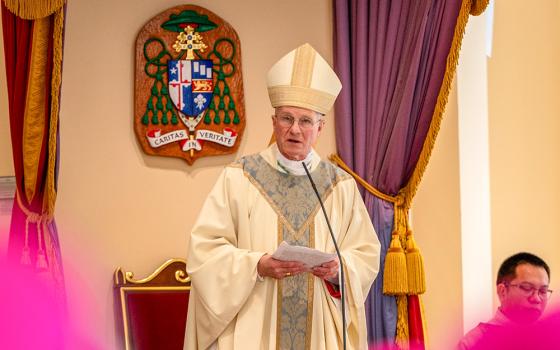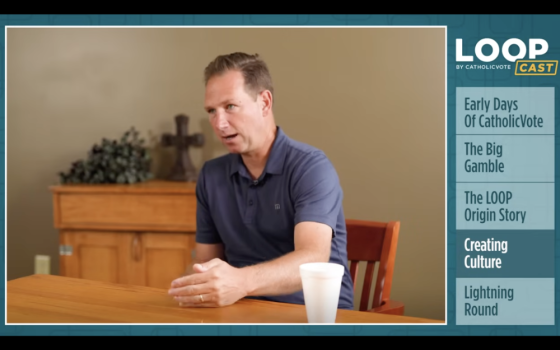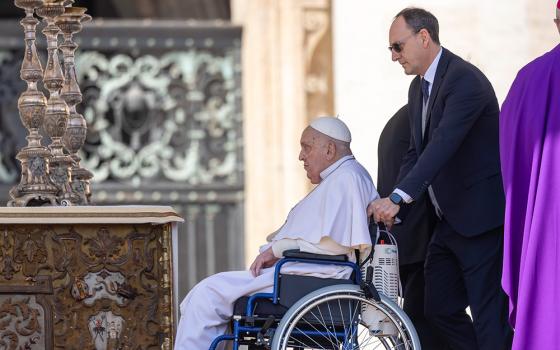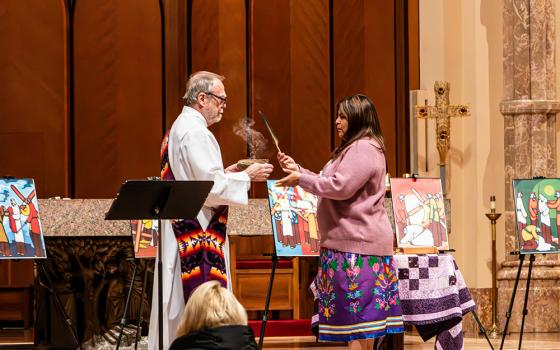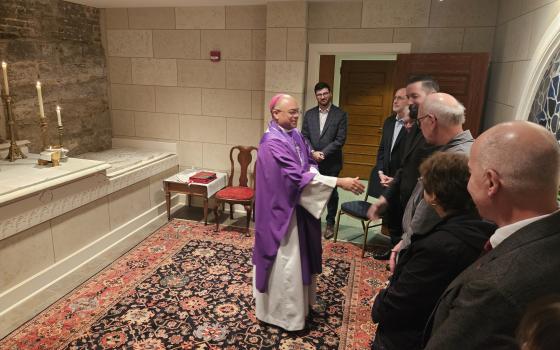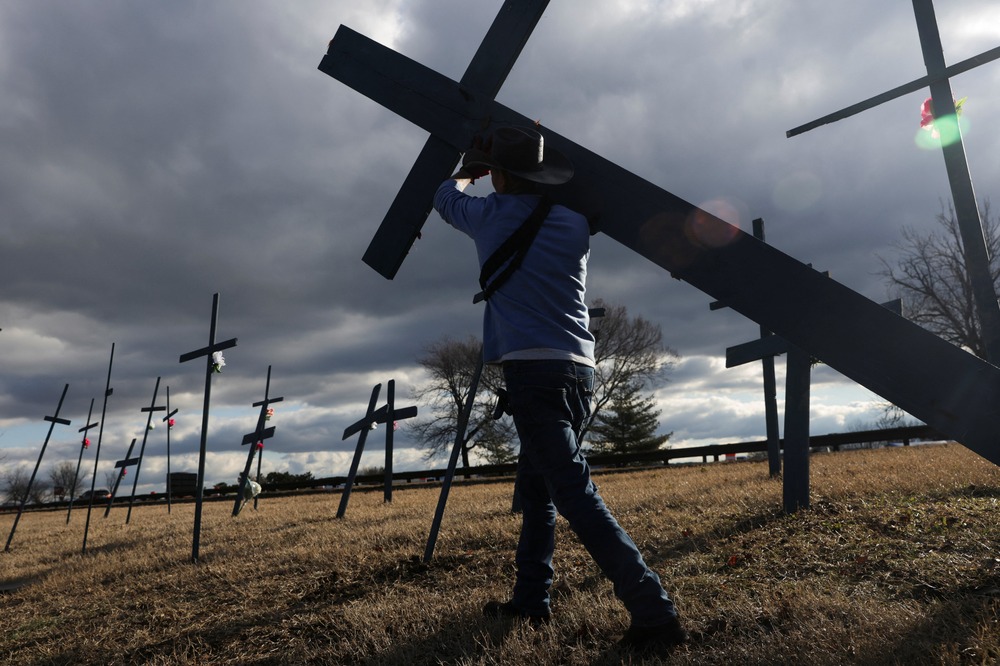
Roberto Marquez from Dallas carries a cross near the Ronald Reagan Washington National Airport, in the aftermath of the collision of American Eagle flight 5342 and the helicopter that crashed into the Potomac River, in Arlington, Va., Feb. 1, 2025. (OSV News/Jeenah Moon, Reuters)
They are silent sentinels.
Painted a somber, stormy ocean blue, others an earthy olive drab, and some still bare wood and awaiting color, dozens of simple crosses — each standing several feet high — are arrayed in orderly rows, with small, bright floral decorations attached to each.
They're planted in a nearly frozen patch of gently sloping ground across the highway from the end of Ronald Reagan Washington National Airport Runway 33 — which late on Jan. 29, American Eagle Flight 5342 was seconds from safely reaching when it instead collided with a U.S. Army helicopter. Both aircraft plunged, in pieces, into the icy Potomac River.
By the afternoon of Feb. 2, there were 67 crosses standing under a leaden gray sky — one for each victim from the Washington aviation disaster, 64 on the jet and three crew on the helicopter. Names will also be added to the crosses, crafted with concerned diligence by Dallas-based Roberto Marquez, a self-trained, immigrant artist originally from Mexico.
He first crossed the U.S. border at age 15 to work in the produce fields of California. Marquez — now 62 — was deported, returned, found stable construction employment, became a citizen, and eventually established a real estate business.
In 2018, he decided to devote himself to painting, including large scale murals.
He's since become known as a disaster artist; his outdoor work sometimes referred to as tragedy memorials. When American daily life is fractured by a public catastrophe — a school shooting; a terrorist attack; an airplane crash — Marquez reliably appears to fashion a grotto of sorts, a space for communal grief and remembrance.
Recently, he was in New Orleans after the Bourbon Street attack that killed 14 and injured 35 on New Year's Day, and in Los Angeles to install both a mural and crosses after the raging wildfires that took at least 29 lives.
"The crosses represent a lot," Marquez told OSV News. "But one of those things is, I do it out of my heart. It's solidarity, and respect, and honor, and remembering those lives."
Although police have effectively quarantined several areas near Reagan National Airport — crews began removing wreckage and the bodies of victims from the river Feb. 3 — people have been stopping at Marquez's installation anyway.
A plane flies over crosses near the Ronald Reagan Washington National Airport as seen from Arlington, Va., Feb. 2, 2025, in the aftermath of the collision of American Eagle Flight 5342 and a Black Hawk Army helicopter late Jan. 29 while the plane was approaching the airport to land. The two aircraft crashed into the Potomac River near the airport. (OSV News/Eduardo Munoz, Reuters)
One woman, Marquez surmised, was a relative of one of those who died.
"It was a lady," he shared. "She was crying, and she had a bunch of flowers."
Asked what his work means, Marquez is reflective. His gentle face and dark eyes steadily gaze out from under the brim of a black cowboy hat.
"Different things. One is that we need to understand that life is really short," he emphasized. "Now, it was these 67 that went away — but who knows what's going to happen to any one of us later? So this is something to remember; pay our respects and send a message that we're united."
In a nation's capital currently awash with political turmoil and partisanship, some might doubt that — but it seems Marquez doesn't.
"This is a good example," he said, indicating the crosses. "The community has been responding. And it's not only me; it's many people. So this is a collective work."r
Is it a ministry?
"People describe it different ways," responded Marquez. "I see it as, I like to do something because it makes me feel good."
Marquez has always used his own funds to build the memorials. He's lost count of the exact number by now — "It has been too many" — but guessed perhaps 50.
"I'm kind of running low on cash," he added. "But there's always people that come and help. A lady just left; she gave me $200. I said, 'I don't want to take it.' I don't ask. But she came to ask me if I would take the money. I said, 'I'm going to take it, because I need it.'"
A sign near one of the crosses — draped with an American flag — indicated an upcoming vigil. Beneath it were dozens of white roses, lined up on a lime green tarp.
While crosses are a definitive Christian symbol, Marquez doesn't identify himself by any specific belief.
"I will tell you what my religion is," he said firmly. "I believe in respect; common sense; reason; truth — and I try to use them; to show it," Marquez explained. "And doing the memorials — and doing this for somebody else — is one way. So that's my religion. Be active; and put it to work."
Advertisement
Unity is a repeated theme in Marquez's thoughtful observations and answers.
"There's one thing that unites us — it has to do with sentiment. When you see somebody crying, I don't pay attention to what religion ... you know?" he asked. "It is that feeling that we as humans have — and that's what unites us."
He paused.
"And I'm sorry to say, but sometimes it's tragedies — and pain comes to our hearts, and that's when we kiss others; we hug; we understand; we're crying," Marquez reflected. "We would like to have just happy moments, but that's not the case. Or maybe to be happy, we need to be sad first. I don't know."
He's not sure where he's going next.
"I don't want to sound pessimistic, but whenever there's another tragedy," Marquez replied. "And the reason is because I want to go and help."
Maybe Philadelphia, where seven people perished after Med Jets Flight 056 — a medical ambulance jet — crashed into a neighborhood Jan. 31.
"If I get the opportunity and maybe the permission," he said, "I will set up the crosses that will represent those lives that were lost in Philadelphia."
Marquez regarded the cross hung with the U.S. flag, and said he would like to add other flags to the memorial.
"I don't know how many countries these people were from. We'll see what we can get," he said. "We'd like to get some different countries' flags."
"We should take every opportunity to not only think about me, or myself, or my family — we've got to do something for others. And it can be done in many, many, many different ways," Marquez said. "There's so many ways. But there's one thing that we need to nurture is love — and practice it. Practice it — and do more practice."
Asked what he'd want to share, Marquez was quick to reply.
"Send out my condolences to those families that are grieving. They're going through this difficult time," he said. "I'm pretty sure there's nothing that is going to make them feel good or better this moment — but maybe later."
Family members of victims visited near the crash site on Sunday, transported to the banks of the Potomac River by a fleet of police-escorted charter buses.
Marquez then had a final word to share.
"We should take every opportunity to not only think about me, or myself, or my family — we've got to do something for others. And it can be done in many, many, many different ways," he said. "There's so many ways. But there's one thing that we need to nurture is love — and practice it. Practice it — and do more practice."

